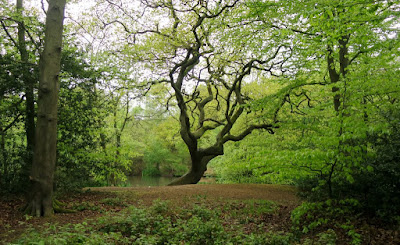Tree spirits are very much a part of cultures around the world (here is a partial list of just some of them). Nowhere is this truer than in India. This vast and complicated country has one commonality that covers all the geographical and cultural regions: The apparent infestation of ghosts in their trees and the acceptance of their presence by locals. Indian ghosts have a preference for particular trees – specifically the fig, banyan, neem, and tamarind. Here is a quick and fun read that illustrates how ghosts are assimilated into everyday life by a family in Kolkata in northern India and here is a cool story about ghosts in southern India.
Silk Cotton trees (aka kapok trees) have a uniquely spooky presence to many people in the Caribbean. They say these trees are haunted because so many slaves (and some criminals) were hung from them. Others say the ghostly spirits were always there. This belief in kapok spirits can be traced back to the West African roots of the enslaved people brought to this region, where this tree is considered sacred (read more here). In an interesting cross-oceanic parallel, the ancient Mayan also saw this tree as sacred. In their tradition, the first human came from a kapok tree.
Almost anyone can be turned into a tree ghost believer if they look long and closely enough at a tree. It is easy to see things there. Whether we invent what we want to see or the spirits are showing themselves is up for discussion. Here is one explanation of why we see faces in trees. A compelling example of this phenomenon is the following story: In the spring of 2017, a storm came through Rochester, NY, and left behind some unusual damage. It tore a large piece out of a tree in Durand-Eastman Park, exposing what looked to be the figure of a woman holding a baby (although not everyone sees the baby part). What makes this particularly unique is that for decades this area has been haunted by sightings of a woman in white, called the White Lady or the Lady of the Lake. She is said to be searching for her lost baby. Could her spirit have been trapped in this tree all this time? Check out the pictures here; they’re pretty impressive.Here are some examples of singularly spooky trees:
In Northern Ireland (another culture with a great affinity for supernatural beings) the village of Finnis, County Down, has a haunted sycamore tree that has been a resident there since the early years of the 20th century. Before that time, there had been a nasty little spirit pestering people around their bridge over the river. A priest eventually trapped it in a bottle and put it in the tree. No one has messed with that tree since. Even powerlines were re-routed around it. See it and read more about it here.
Sometimes haunted trees produce more than just goosebumps. In the case of an apple tree in Franklin, Connecticut, its flowers and fruit tell a haunting tale. The story goes that in the mid-1750s, a farmer murdered a peddler and buried him under an apple tree. In some versions of the story, the farmer can’t handle the guilt and hangs himself from the same tree. No matter the version, when the trees bloomed in the spring the flowers were crimson-red instead of white, and when the apples appeared they had strange, blood-colored flesh. The actual tree in question most likely was downed by a hurricane in 1938, but these apples (known as Micah Rood apples) are still in existence. Some of this story is true, some is not and some may be. Go here to learn more.
more here or see a video here.Whether you call them spirits or ghosts or something else entirely, it seems clear that trees have a presence that is unique to each individual. And, like all individuals in a larger whole, not all of them are nice.
Take Care.
Submitted by Pam














No comments:
Post a Comment